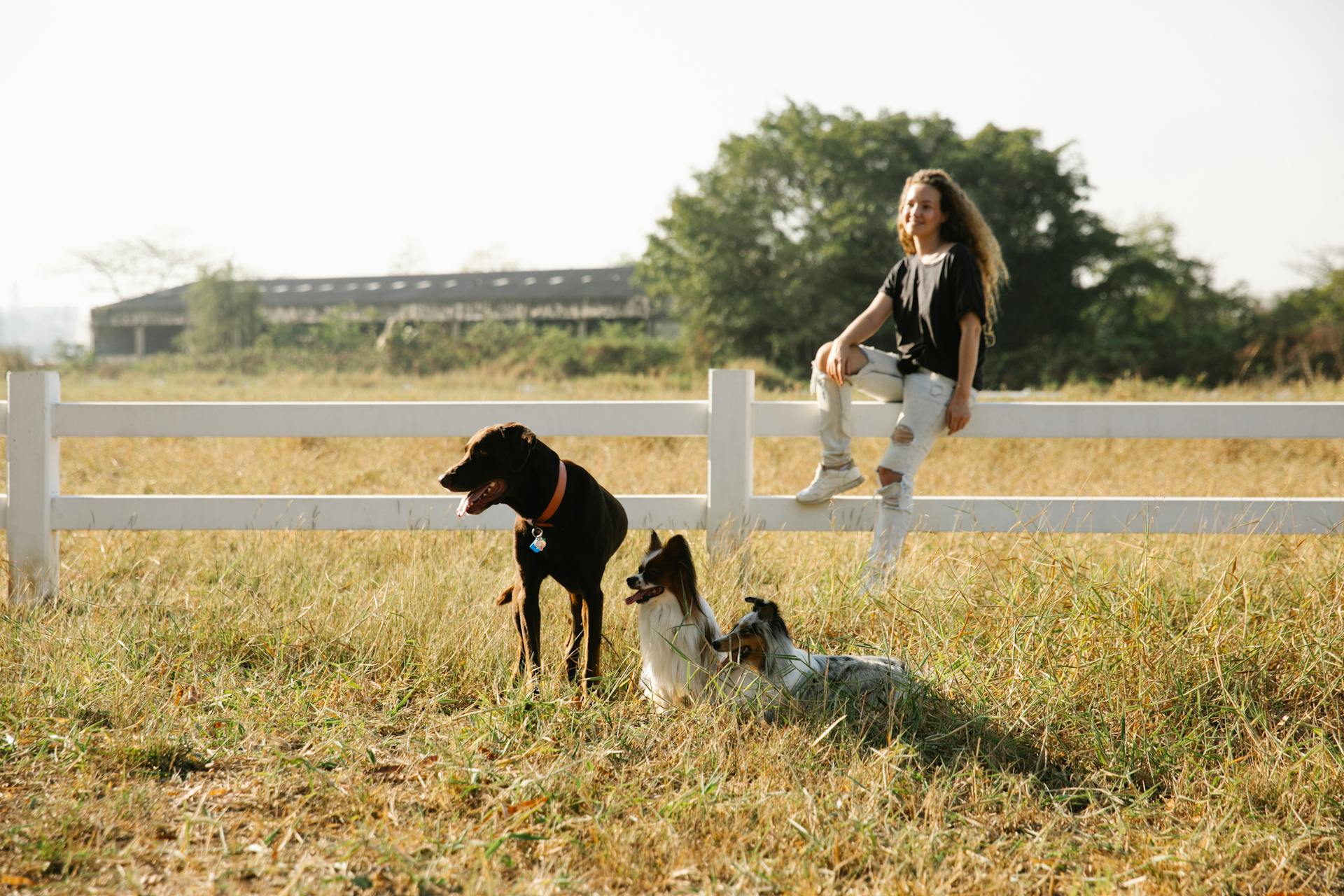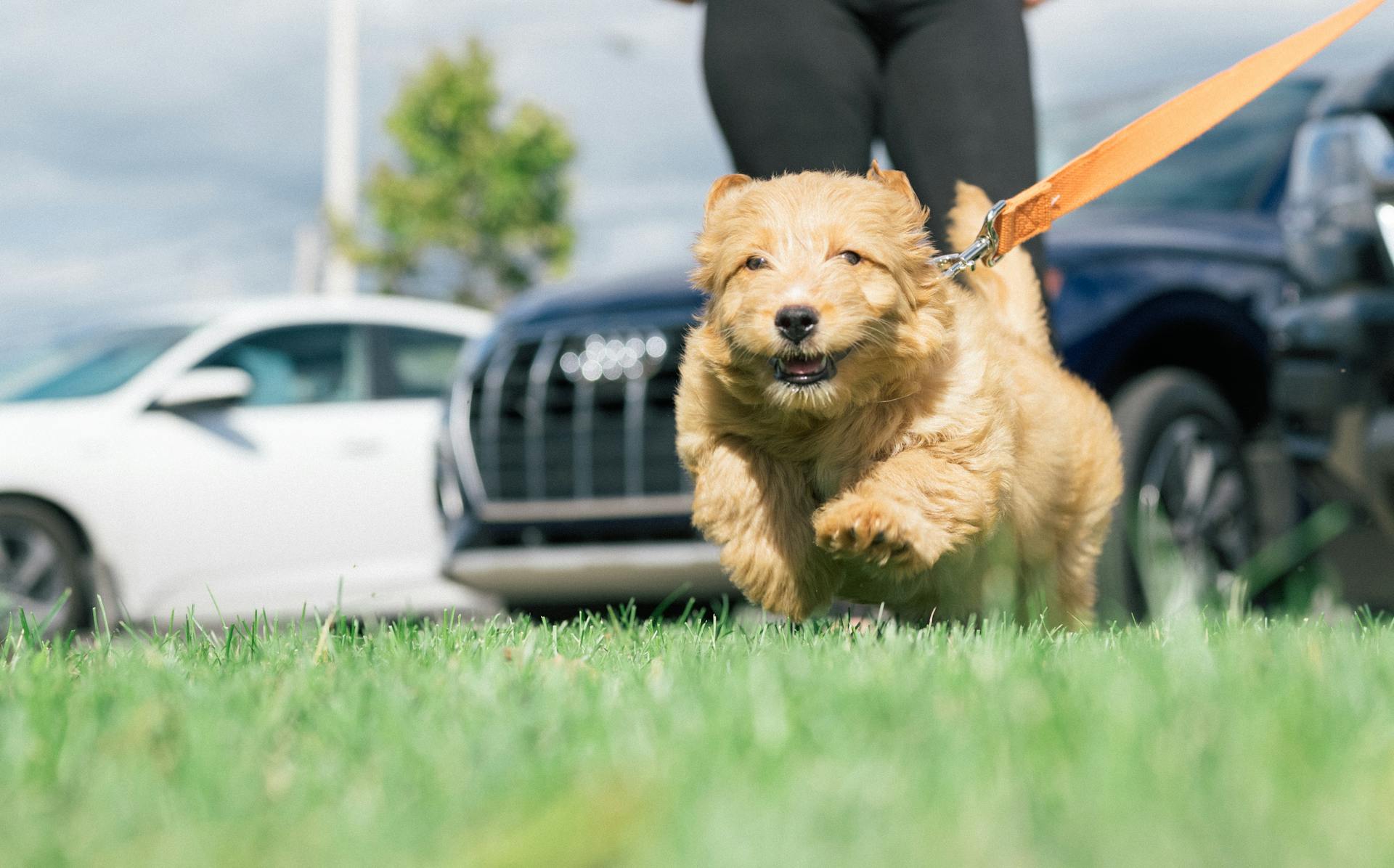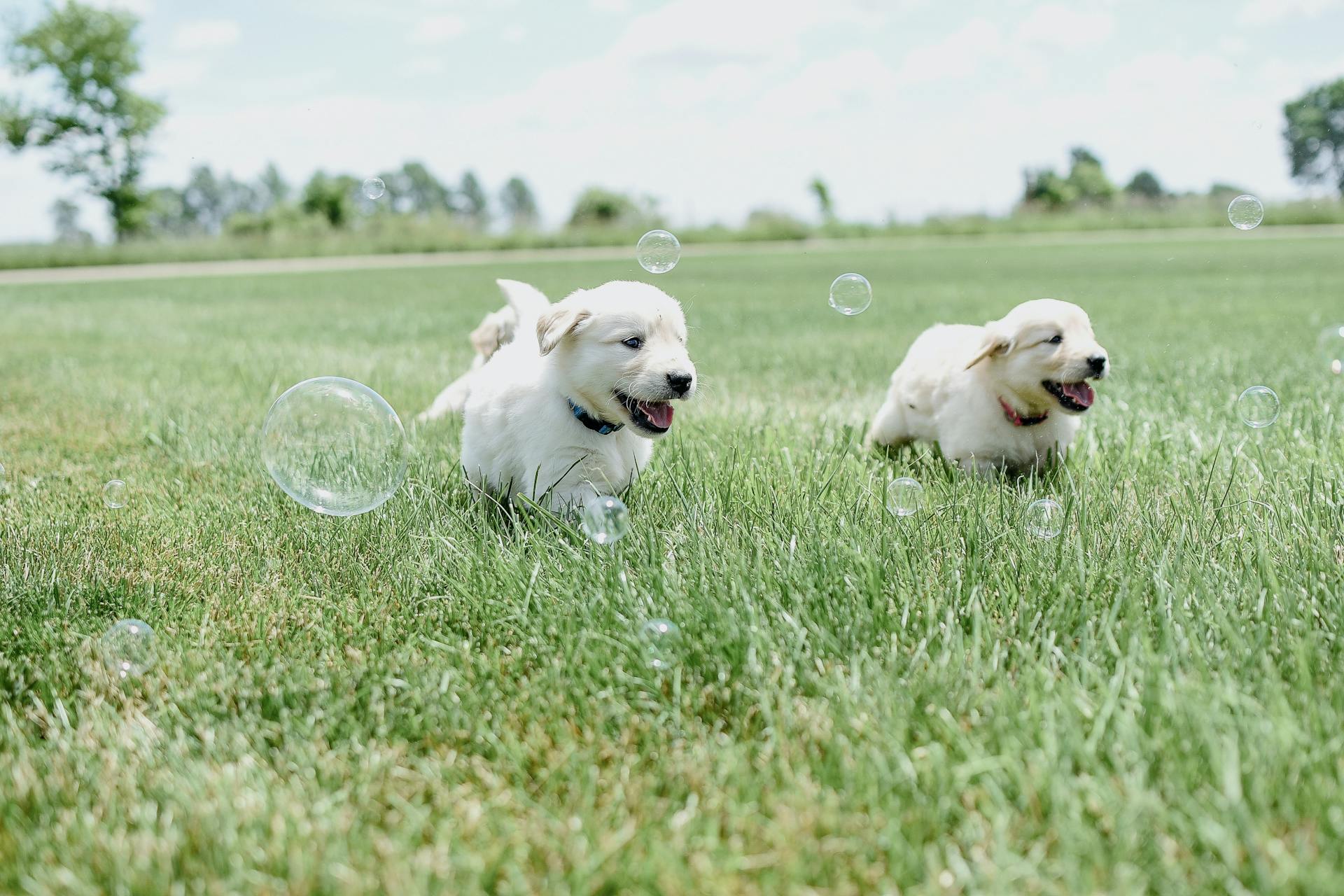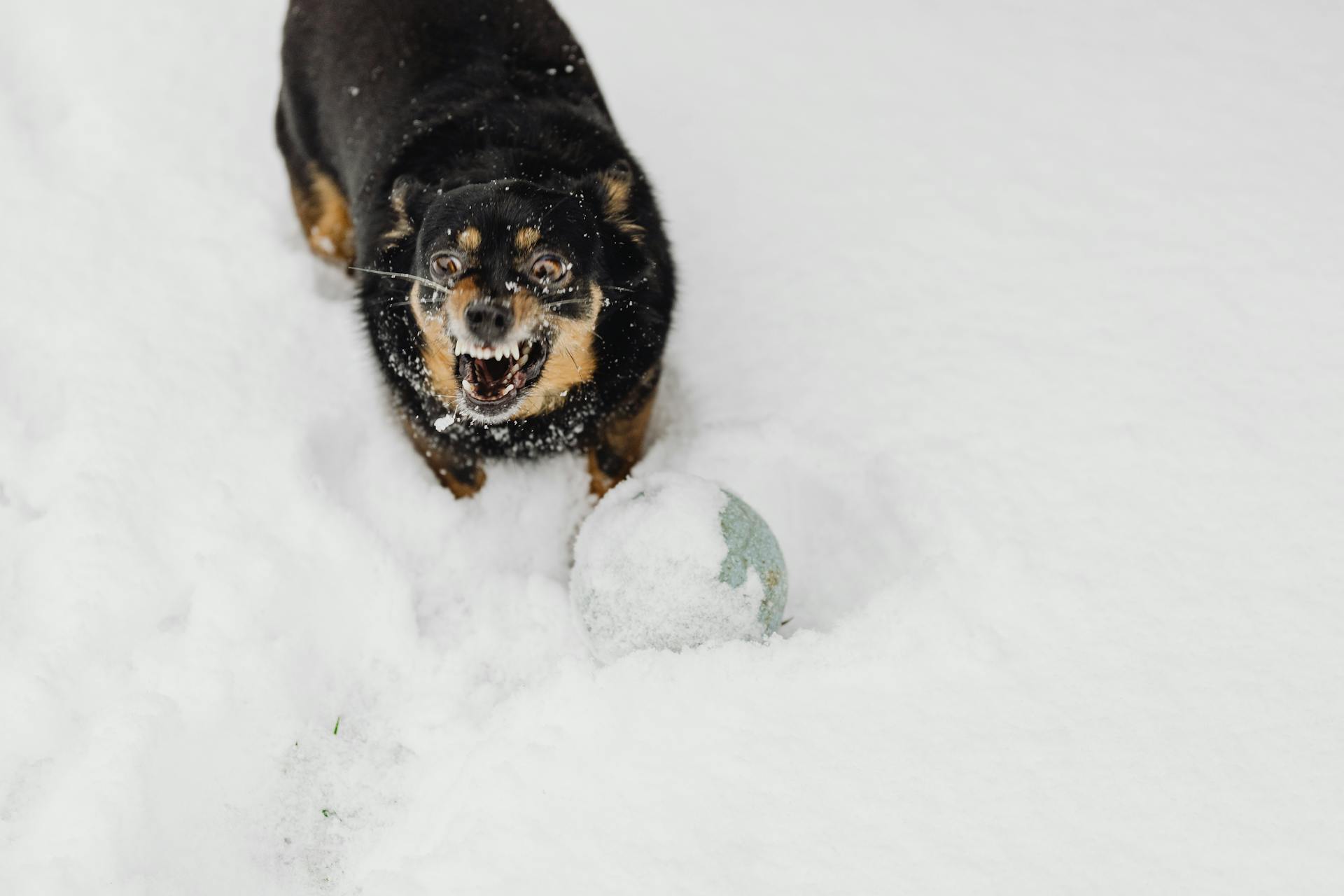
Aussiedoodles are a cross between an Australian Shepherd and a Poodle, and their shedding level can vary greatly depending on their generation and genetics.
They can have a low, moderate, or high shedding level, with some owners reporting minimal shedding, while others experience heavy shedding.
The Australian Shepherd's influence can lead to moderate to heavy shedding, while the Poodle's genetics can result in a low-shedding coat.
Some Aussiedoodles may inherit the Poodle's low-shedding trait, requiring regular grooming to prevent matting and tangling.
Recommended read: Miniature Poodle Shed
Aussiedoodle Coat Characteristics
Aussiedoodles' coats are as unique as their personalities, with a blend of their Australian Shepherd and Poodle lineage.
Their coats come in various colors commonly seen in Australian Shepherds, including blue merle, red merle, black and red tri, black and tan (referred to as ‘phantom’), parti, sable, and occasionally even solid colors.
Aussiedoodles can inherit a wavy coat or tighter curls reminiscent of their Poodle ancestry, or even a straight coat from their Australian Shepherd side.
You might enjoy: Full Grown Red Aussiedoodle
Some Aussiedoodles display a curly coat, while others exhibit a wavy coat, both inherited from their Poodle parent.
Their coat texture and type play a significant role in determining their shedding patterns.
Aussiedoodles with shorter hair may be a more suitable option for allergy sufferers, but this isn't a guarantee.
Their coat type is a major factor that determines if your Aussiedoodle will shed or not, with three types of coats: curly, wavy, and straight.
Early socialization will help Aussiedoodles get along with other pets, but it's essential to introduce them slowly and calmly to avoid any issues.
Their coat color and pattern don't necessarily impact their shedding level, but it's essential to consider their individual characteristics when deciding on grooming needs.
Genetics and Shedding
Genetics significantly affect your dog's coat type, and an Aussiedoodle's shedding pattern can be somewhat predicted by looking at their parents' coats.
Parentage is a huge determinant of hereditary traits your canine will possess, including shedding.
The Australian Shepherd and Poodle are the parents of the Aussiedoodle, and it gets traits from both parents.
F1 Aussiedoodles possess 50% Poodle DNA and 50% Australian Shepherd DNA, making them likely to shed at least a little.
Shedding in Aussiedoodles varies, and some shed, some rarely do, while some might not even shed at all, based on two determining factors: Genetics and Coat Type.
If your Aussiedoodle happens to shed, it is possible that it inherited the genes of its double-coated Australian shepherd parent.
Shedding is never an exact science when it comes to mixed breeds like the Aussiedoodle, since they're a hybrid between a non-shedding breed and a shedding breed.
More than likely, your F1 Aussiedoodle will be in the middle of the spectrum, with some shedding and some not.
On a similar theme: F1 Mini Aussiedoodle Full Grown
Shedding Levels and Factors
Shedding levels in Aussiedoodles vary, some shed, some rarely do, while some might not even shed at all. This is based on two determining factors: Genetics and Coat Type.
Genetics play a significant role in determining an Aussiedoodle's shedding level. Since they're a hybrid between a non-shedding breed and a shedding breed, some Aussiedoodles shed while others don't.
Coat type is also a determining factor. The generation of your Aussiedoodle is often a good indicator of how likely they are to shed.
The amount of shedding can also depend on the time of year. Many dogs, including Australian Shepherds, shed more as the seasons change from warm to cold and vice versa. This is because their coats react to the change in air temperature and naturally become lighter or heavier to keep their body temperature regulated.
Aussiedoodles can shed minimally, and the amount of shedding can vary depending on their genetic makeup, diet, and more. You probably won't be able to tell for sure if your dog is a seasonal shedder until they are about two years old.
For another approach, see: Bernedoodle Color Change
Grooming and Maintenance
Aussiedoodles require regular grooming to manage their shedding, which can vary depending on their coat type. They need to visit a groomer every three months for professional retouch, and a bath every 1-2 weeks.
Brushing is essential to prevent matting and tangling, especially for curly-haired Aussiedoodles that need daily brushing. Wavy coat Aussiedoodles require less frequent brushing.
Aussiedoodles can have one of three main coat types: straight, wavy, or curly. Each type has its shedding tendencies, with curly coats being the least shedders.
Regular brushing helps distribute natural oils, reducing breakage and shedding. Brushing at least once a week can prevent matting and tangling.
Using a high-quality brush like the Chris Christensen Big G Slicker Brush can make a big difference in managing shedding. De-shedding tools like the Furminator can also be helpful.
Bathing is another important part of grooming, with a monthly bath recommended to remove unwanted hair. Using de-shedding shampoo, like Burt's Bees Shed Control Shampoo, can be beneficial.
Aussiedoodles can be prone to shedding, especially during seasonal changes, so regular brushing and grooming are crucial. They can also be a bit messy, so having a vacuum specifically designed for pet hair can be a lifesaver.
Here are the three main coat types and their shedding tendencies:
Dealing with Shedding
If you bring home an Aussiedoodle puppy, it's best to assume that it'll shed at least a little.
Shedding is never an exact science when it comes to mixed breeds like the Aussiedoodle, so some Aussiedoodles shed while others don't.
Your Aussiedoodle may shed for a variety of reasons, some of which are normal and some of which may indicate they're experiencing a health issue.
To minimize shedding, consider your dog's genetic makeup, diet, and other factors that can influence shedding.
If your Aussiedoodle sheds, be prepared for it to shed at least minimally, and keep in mind that some Aussiedoodles shed more than others.
To manage shedding, keep reading to learn why Aussiedoodles shed, situations that may cause your Aussiedoodle to shed more than normal, and our favorite tricks to minimize shedding around your house.
Aussiedoodle Generations and Shedding
F1 Aussiedoodles typically have 50% Poodle DNA and 50% Australian Shepherd DNA, making them likely to shed at least a little.
Their shedding can vary from moderate to heavy, but some F1 Aussiedoodles may be fully non-shedding.
F2 Aussiedoodles have a mixed gene pool, making their shedding hard to predict. Many have a flat coat like the Australian Shepherd, which sheds significantly.
F1B Aussiedoodles, being a mix of an Aussiedoodle parent and a full-blood Poodle parent, have roughly 75% Poodle DNA, making them less likely to shed than F1 Aussiedoodles.
F1BB Aussiedoodles, with 87.5% Poodle DNA, are highly unlikely to be shedders and may closely resemble a Poodle in appearance.
Explore further: F1 Aussiedoodle
F1 Doodles
F1 Doodles, like F1 Aussiedoodles, possess 50% Poodle DNA and 50% of the other breed's DNA.
These dogs are likely to shed at least a little due to the large percentage of the other breed's genes.
F1 Doodles are not fully non-shedding, but some may shed less than others.
Related reading: Baby Golden Doodles
F1B
F1B Aussiedoodles are a cross between an F1 Aussiedoodle and a full-blood Poodle, resulting in a higher percentage of Poodle DNA, typically around 87.5%.
This increased Poodle DNA makes F1B Aussiedoodles even less likely to shed than F1 Aussiedoodles, which have around 75% Poodle DNA.
Their coats can still be varied, but they tend to be more hypoallergenic, making them a great option for those with allergies.
The F1B generation is a step closer to the Poodle side, which is known for its low-shedding trait.
As a result, F1B Aussiedoodles are often preferred by those who want a low-maintenance coat.
Their coats require regular grooming to prevent matting and tangling, but they are generally easier to care for than other Aussiedoodle generations.
Suggestion: F1b Aussiedoodle Black
F1BB
F1BB Aussiedoodles are the generation most similar to a purebred Poodle in DNA, with 87.5% Poodle DNA. This makes them highly unlikely to be shedders.
Their appearance closely resembles a Poodle, making them a great option for those who want an Aussiedoodle but can't tolerate shedding.
F2 Doodles
F2 Doodles are a mixed bag when it comes to shedding. Their gene pool is very mixed and hard to predict, making it difficult to know what to expect.
Many F2 Doodles have a flat coat like the Australian Shepherd, which will shed significantly.
Take a look at this: F2 Aussiedoodle
Aussiedoodle Grooming and Shedding
Aussiedoodles have coats as unique as their personalities, and shedding is a big part of that. The Aussiedoodle coat is a cross between an Australian Shepherd and a Poodle, resulting in a coat that's as varied as it is beautiful.
Regular brushing is essential for Aussiedoodles, and it should be done at least 2-3 times a week, but daily brushing during shedding seasons is ideal. This will help detangle and gently remove loose hair, especially for curly and wavy coats.
The type of brush to use depends on the coat type, with a slicker brush suitable for curly and wavy coats, and a bristle brush for straight coats. Aussiedoodles with long, floppy ears need regular ear cleaning, and the hair around their eyes should be kept trimmed to avoid irritation.
Aussiedoodles come in a range of colors, including blue merle, red merle, black and red tri, black and tan, parti, sable, and solid colors. Their coat texture can also vary, with some having wavy coats and others exhibiting tighter curls reminiscent of their Poodle ancestry.
For your interest: Tri Colored Aussiedoodle
Here's a quick guide to brushing and grooming your Aussiedoodle:
- Brush your Aussiedoodle at least 2-3 times a week, but daily during shedding seasons.
- Use a slicker brush for curly and wavy coats, and a bristle brush for straight coats.
- Bathe your Aussiedoodle every 4-6 weeks, or as needed, using a dog-specific shampoo and conditioner.
- Trim the hair around your Aussiedoodle's eyes to avoid irritation.
- Take your Aussiedoodle to the groomer every 3 months for a professional retouch.
- Bathe your Aussiedoodle every 1-2 weeks, depending on how long you spend outdoors.
Frequently Asked Questions
Are Aussiedoodles hypoallergenic?
Aussiedoodles are considered hypoallergenic, but regular grooming is still necessary to manage their shedding.
Are Aussiedoodles low shed?
Aussiedoodles can be low shed, but it depends on their individual mix of Australian Shepherd and Poodle traits. Some Aussiedoodles inherit the Poodle's low-shedding characteristic, while others may shed more like their Aussie ancestors.
Sources
- https://www.riverviewgrooming.com/post/do-aussiedoodles-shed-insider-insights-from-a-dog-groomer-on-their-coats
- https://dogtime.com/dog-breeds/aussiedoodle
- https://www.aussiedoodling.com/post/why-does-my-aussiedoodle-shed
- https://www.northidahominiaussies.com/general-9
- https://populardoodle.com/do-aussiedoodles-shed-the-facts-and-myths-about-aussiedoodle-shedding/
Featured Images: pexels.com


